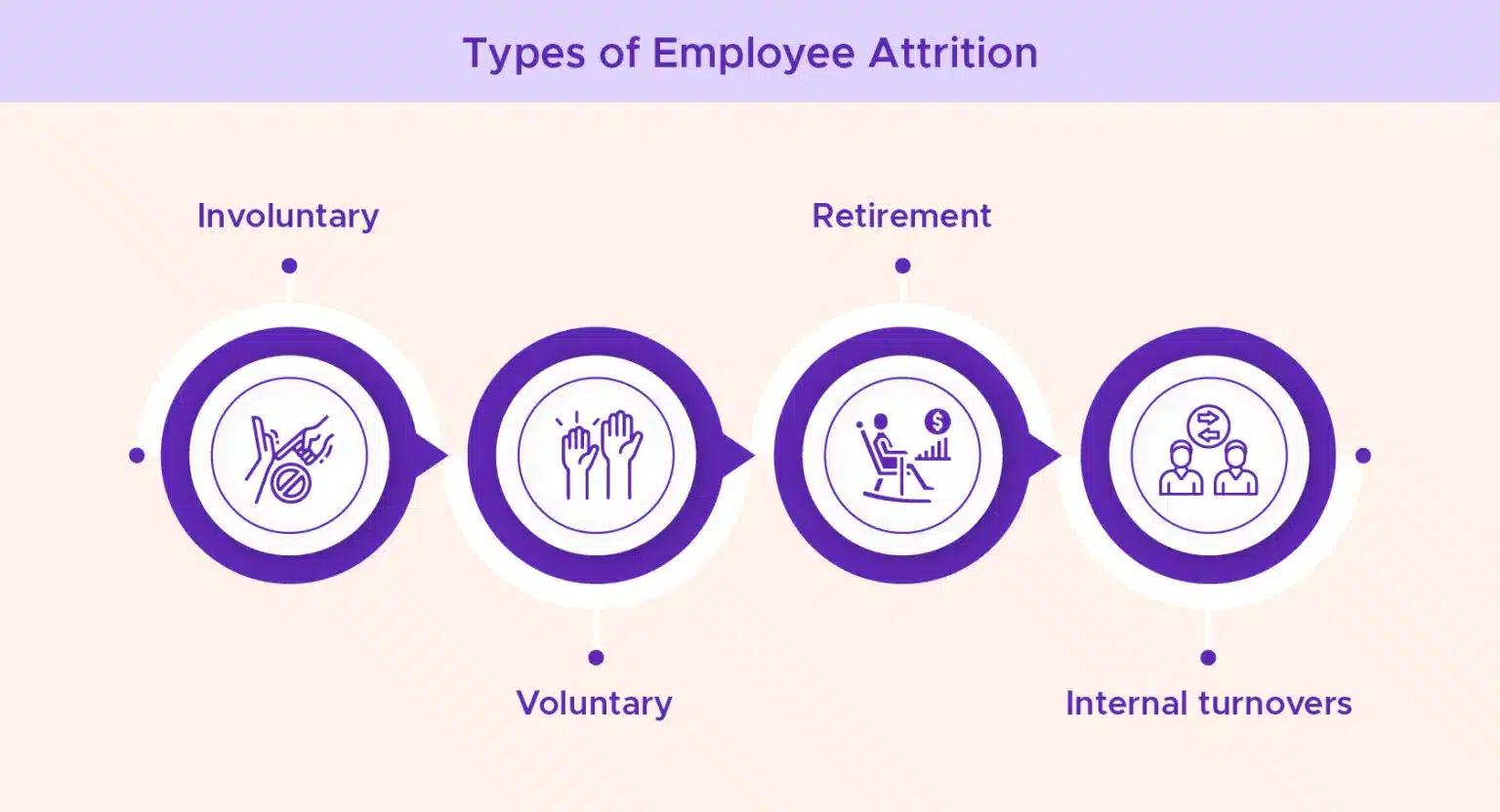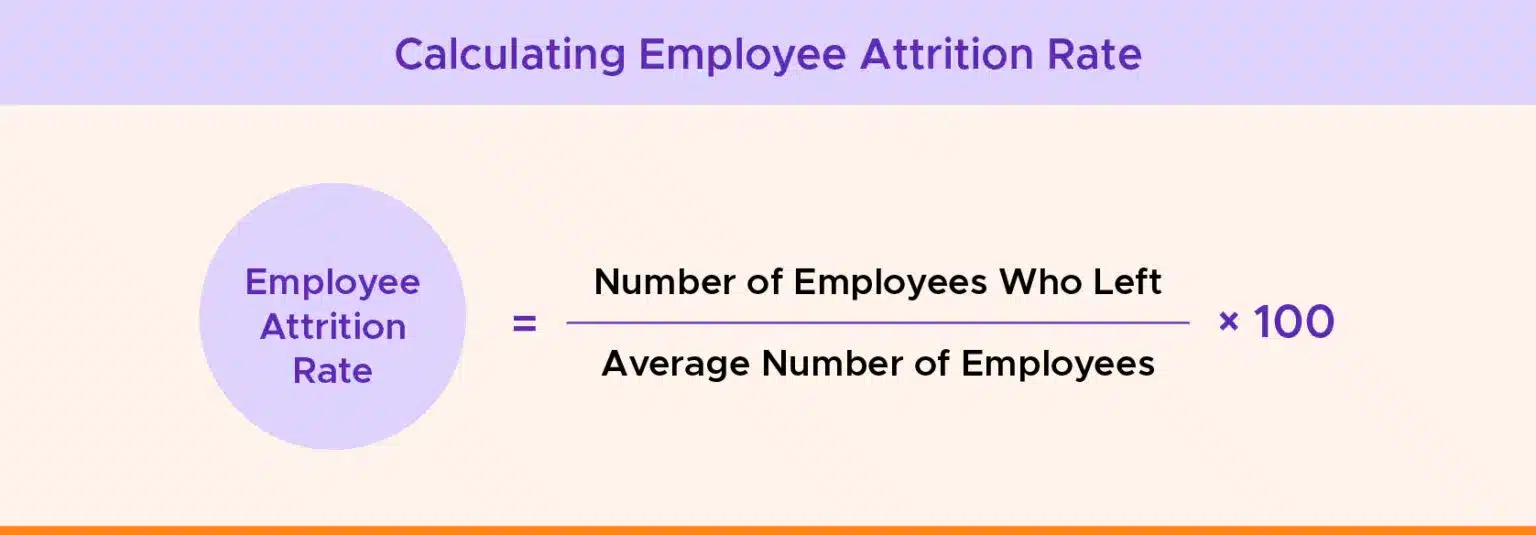According to Gallup, 1 in 2 employees are open to leaving their organization if given the opportunity.
Although you cannot control organic reasons for leaving, like retirement, you can always do something about employees choosing to leave your organization with the right retention strategies.
But first, you need to understand what employee attrition is and what strategies can identify and prevent excessive attrition.
Let’s get into it.

What is Employee Attrition?
Employee attrition is the gradual reduction in a company’s workforce due to employees leaving and not being replaced immediately or at all. It’s a natural process that occurs in every organization, but it can become problematic if the attrition rate is too high.
Say you have a company with 100 employees. Within a year, some of your employees leave the company. They’ve either retired, found a new job, gotten fired, or left because they were unhappy with their workplace.
Now, if an employee leaves and the company decides not to fill that position again, or there is a delay in hiring for that position, that’s called attrition.
It’s like the company is slowly shrinking because those empty positions aren’t being refilled quickly enough or at all. Maybe the work gets divided up among the remaining employees, or maybe that position just isn’t needed anymore or is put on hold.
Now, attrition is normal and happens in every company. It only starts being a problem if the rate is too high, or if your top performer leaves. That means you have experienced employees with institutional knowledge leaving at an alarming rate, costing you time and productivity. It also means that you’re hiring to fill these roles, but not fast enough, and spending more money on recruiting and training.
While retirement and firing employees is not something you need to fix (as these are natural events), lots of employees terminate their jobs due to a lack of opportunity and job satisfaction. These happen to be problems you can fix with effective retention strategies.

Employee Attrition vs. Employee Turnover: Understanding the Key Differences
Usually, the terms “attrition” and “turnover” are used interchangeably. However, it is important to note that they have different meanings:
Attrition is the process of gradually reducing the number of employees in a company when they leave on their own or are asked to go but not replaced immediately. In this case, staff numbers decrease over time as a result of vacancies created by retirements, resignations, and dismissals, among other reasons, which may remain unfilled.
Instead of hiring new workers for these positions, an organization may decide to do away with them altogether, share out duties among existing staff, or simply hire at a later date.
On the other hand, employee turnover refers to all types of employee churn, including voluntary (resignations) and involuntary (terminations), as well as situations where replacements are found immediately after someone quits their job. It can happen with or without net headcount loss. It measures how many people join and leave an enterprise over a certain period — not overall shrinkage in workforce size.
Employee attrition vs Employee turnover
| Factor | Employee Attrition | Employee Turnover |
| Definition | A gradual reduction in workforce due to employees leaving and not being replaced immediately or at all | The rate at which employees leave a company and are replaced by new hires |
| Impact on Workforce | Reduces the total number of employees over time | Maintains or changes the total number of employees, depending on the balance between departures and new hires |
| Reasons for Occurrence | Retirement, voluntary resignations, terminations, or organizational restructuring | Voluntary resignations, terminations, or organizational restructuring |
| Management Approach | Focus on workforce planning, succession planning, and knowledge transfer to mitigate the impact of attrition | Focus on improving employee retention, addressing the root causes of turnover, and streamlining the hiring process |
Knowing the difference between attrition and turnover will help you make accurate diagnoses of workforce trends. High rates of staff leaving can suggest problems with employee involvement, pay systems, supervision, or organizational culture, which need remedial action. Planned attrition is less harmful for organizations, but too much of it still hurts productivity and morale of your employees.
Exploring Different Types of Employee Attrition
All forms of employee attrition are not equal; there are various categories characterized by different features, causes, and potential consequences. Here are the types of employee attrition:

Involuntary Attrition (Unregretted Attrition)
This category applies when the employer rather than the worker initiates separation. This could be due to unsatisfactory job performance, breach of company rules or policies, or corporate reorganization due to mergers, acquisitions, or strategic shifts. Layoffs also fall into this bracket.
Though never pleasant for those affected, involuntary attritions can sometimes prove necessary for organizations. If managed professionally and compassionately, they can help address underperformance and keep financial stability intact.
Voluntary Attrition (Regrettable Attrition)
Voluntary attrition occurs when employees quit their current jobs. This may happen due to better working environments elsewhere, other opportunities, or personal reasons.
The impact of this form of employee attrition can be severe for your business if you keep losing highly skilled staff members. They might join rival firms, giving them a competitive advantage. They leave behind large gaps in terms of knowledge and experience, and frequent departures demoralize teams.
Retirement Attrition
This refers to permanent withdrawal from the workforce upon reaching retirement age. This is a normal stage in the employment cycle, but it carries significant weight especially if many long-term employees retire at the same time.
This causes an abrupt loss of knowledge about the company and mentoring, and the only way to deal with it is to plan for succession and knowledge transmission.
Internal Turnovers And Turnover By Demographics
Internal turnovers happen when employees leave their current position within an organization to take up another role or department in that same organization.
Internal turnovers support employee retention and career progression while motivating employees. But it may also fail terribly by creating skills gaps in critical areas, if not planned well.
Demographic-based attrition refers to higher rates of quitting among certain groups of workers that share the same ages or genders. If people from the same race start quitting more frequently than others, then this might indicate unfair treatment, which you need to address immediately.
The Impact of Employee Attrition
High attrition can negatively impact a company’s performance, culture, and financial status. If unaddressed, high rates of staff turnover erode firm stability and future success. Let us look at some of these outcomes.
Missed Goals, Reduced Productivity and Profitability
Losing your top performers sets off a chain reaction that undermines your ability to meet targets and execute plans effectively. When skilled employees leave, they take with them valuable knowledge, experience, and expertise, leading to a decline in overall productivity. The remaining team members are left to shoulder additional responsibilities, which can result in burnout and increased stress levels, ultimately lowering employee satisfaction.
This disruption in workflow coupled with the extensive learning curve for new hires makes meeting deadlines, maintaining quality standards, and delivering consistent results difficult. You’re less efficient as an organization, and this happening repeatedly will simply decrease your profitability in the long run.
Disrupted Team Morale and Engagement
Morale among employees who stay behind could be affected negatively by attrition. Even if temporarily, the workload on team members almost always goes up with an employee’s departure.
Frequent departures make it almost impossible to create a healthy company culture if there’s a revolving door of employees in your company. If you fail to deliver a satisfying employee experience, attracting and retaining talent becomes a lot harder.
Increased Hiring and Training Costs
Attrition has financial implications beyond lost productivity: recruiting, onboarding, and training replacements lead to increased expenses for job postings, background checks, and orientation programs.
It takes time for new employees to reach the same level of proficiency as their predecessors, during which the company may experience reduced output and quality. The cumulative cost of these factors can put a substantial strain on your organization’s budget and profitability.
Identifying Signs of Employee Attrition: Proactive Measures for Retention
To mitigate the negative consequences of attrition, it’s necessary for you to recognize warning signs and take proactive steps to retain valuable employees. Here are some common warning signs you should look out for:
Decreased Productivity and Engagement
One of the clearest indications that your employees are thinking about leaving is when their engagement and productivity suddenly dives.
For example, if a previously high-performing employee consistently fails to meet deadlines, produces low-quality work, shows disinterest during meetings with other colleagues, and doesn’t show up — they might be leaving. Why try to do well if you don’t plan on sticking around?
You need to pay closer attention to changes like these. Though it might be too late, it is well worth your effort to initiate open discussions and attempt to understand why they want to leave, and if you can do anything to change their minds. Of course, this is easier said than done, if they do not want to admit they are leaving or divulge their reasons.
Peoplebox streamlines employee management by offering a suite of features. Managers can conduct regular check-ins to gauge team member engagement and motivation. Additionally, Peoplebox’s performance management platform helps identify and reward high performers. Finally, it seamlessly integrates with various workforce management tools, allowing for automated updates on key results, saving time and effort.

Increased Absenteeism
An abrupt rise in absenteeism, especially if it is unexplained, could be signaling impending attrition. When people start calling in sick frequently or taking more personal days than usual, this is because they have become demotivated and therefore are failing to show up at all or are actively going to interviews elsewhere while still working for your business.
Occasionally absenteeism is fine, and even prolonged periods are okay if your employees bother to explain why — life happens and work will take a backseat on some days. However, you do need to be worried if employees call in sick with zero notice and don’t make much of an effort to explain it, this could signal that they have mentally checked out.
Changes in Behaviour or Attitude
Extreme changes in behavior could be a sign of potential attrition. If a colleague who used to be passionate and cooperative starts showing signs of withdrawal, like not talking much or becoming negative or uninterested in their work, then it implies deeper dissatisfaction that you need to address.
You can do this by establishing an environment where employees can freely share their concerns, which you can then work on collectively.

Frequent Complaints or Negative Feedback
When team members start complaining about management practices, workload distribution, and lack of clarity in job roles, among other things, this shows that they are becoming very dissatisfied with how the business is run, which could result in many quitting the company over a period of time.
As a human resource manager, take these complaints up and investigate the truth behind them. Take immediate steps to rectify genuine issues to reduce the negative impact of attrition in your company. The added benefit is that this demonstrates your company’s true commitment toward employee welfare, and you’re constantly refining how the workplace runs and amplifying retention efforts.
Measuring Employee Attrition for Organizational Insight
You need to analyze attrition to determine the direction of staff dynamics. By understanding attrition patterns, you can detect potential problems, create rock-solid retention plans, and enhance your talent management strategies.
Let’s talk about how you can calculate employee attrition, understand it, and know whether your business is within the ideal range for it.
Calculating Employee Attrition Rate

Follow these steps when calculating the employee attrition rate:
- Determine the time frame over which you want to calculate attrition (e.g., monthly, quarterly, annually).
- Calculate the average number of employees during that period by adding up the number of employees at the beginning and end of it, then divide by 2.
- Count how many people left an organization within this same period including those who went voluntarily or involuntarily. Remember that we don’t consider involuntary departures in some turnover calculations, but in attrition we do.
- Apply this formula for attrition rate: (Number of Departures ÷ Average Number of Employees) × 100.
For example, if a company had 100 workers at the start of the year and 120 at the end of the year with 15 employees leaving during that year, then the annual attrition rate would be calculated as follows: (15 ÷ ((100 + 120) ÷ 2)) × 100 =13.64%.
Conducting Attrition Analysis For Trends And Patterns
Calculating overall staff turnover is just the first step towards gaining deeper insights into what may be causing certain people to leave frequently.
You need to conduct a comprehensive data analysis that looks for trends or patterns that may be leading to higher attrition numbers. indicated by such reviews. Here are some factors that should guide your analysis:
- Break down departure rates according to departmental level, location, job category/level, or even tenure/demographic characteristics to identify areas having higher concentrations of risk.
- Evaluate common reasons behind exits by conducting exit interviews/surveys to understand the main drivers of attrition.
- Track rates over a certain period to determine if there could be any seasonality about employees leaving. Do their departures coincide with significant changes within the organization, like mergers and acquisitions?
You can use Peoplebox to deliver your surveys and exit interviews. The following features would make it easy:
- Peoplebox provides a question library where you can browse and filter questions by drivers.
- Once you have created the survey and selected the questions, you can schedule the survey to be sent to all employees in the company. This makes it easier for you to establish regular surveys as one of your best practices.
- Peoplebox enables you to set up automated pulse surveys, allowing you to regularly collect feedback from employees at predefined intervals. You can also use this to identify development opportunities for your employees.
Understanding Attrition Benchmarks in Your Industry
Find out industry-specific benchmarks on employee churn through professional associations, industry reports, or even independent HR research firms. Keep an eye on the reports published by the Bureau of Labor Statistics. This will help you gauge how your organization compares against others within the same industry, this is especially important as these are the organizations competing for talent in the same pool.
If your attrition rate exceeds significantly beyond the acceptable rates, you need to step up retention efforts. On the flip side, lower-than-expected turnover numbers may be good, but they indicate that you are holding on to employees that you are better off without, driving up labor costs in the long run.
| Attrition Rates for Different Industries | |
| Industry | Attrition Rate |
| Construction | 54% |
| Manufacturing | 37% |
| Trade, Transportation and Utilities | 49% |
| Information | 32% |
| Financial activites | 29% |
| Professional and Business Activities | 57% |
| Education and Health Services | 39% |
| Leisure and Hospitality | 79% |
| Government | 18% |
Mastering Attrition for a Flourishing Workforce
Managing employee attrition effectively can lead to engaged workforce development. However, traditional approaches towards this end may not work well due to the complex nature of modern organizations coupled with changing expectations from employees. Peoplebox can help with that.
Peoplebox is an all-in-one OKR, performance management and people analytics platform designed to help you align the people in your company with business strategy goals.
A major benefit of Peoplebox is that it aligns individual and team goals to broader organizational objectives. When employees can see how their daily tasks connect with what the company wants to achieve overall, they are likelier to feel interested in their work and stay motivated. This kind of alignment serves as a powerful cure for disengagement and disconnect — two common causes of attrition.
Peoplebox also features strong people analytics functions which enable HR teams to monitor essential data points, recognize patterns, and base their decisions on facts. Businesses should use these findings from performance reviews, engagement surveys, or other touchpoints to detect early signs of turnover risks and fine-tune talent strategies proactively.








